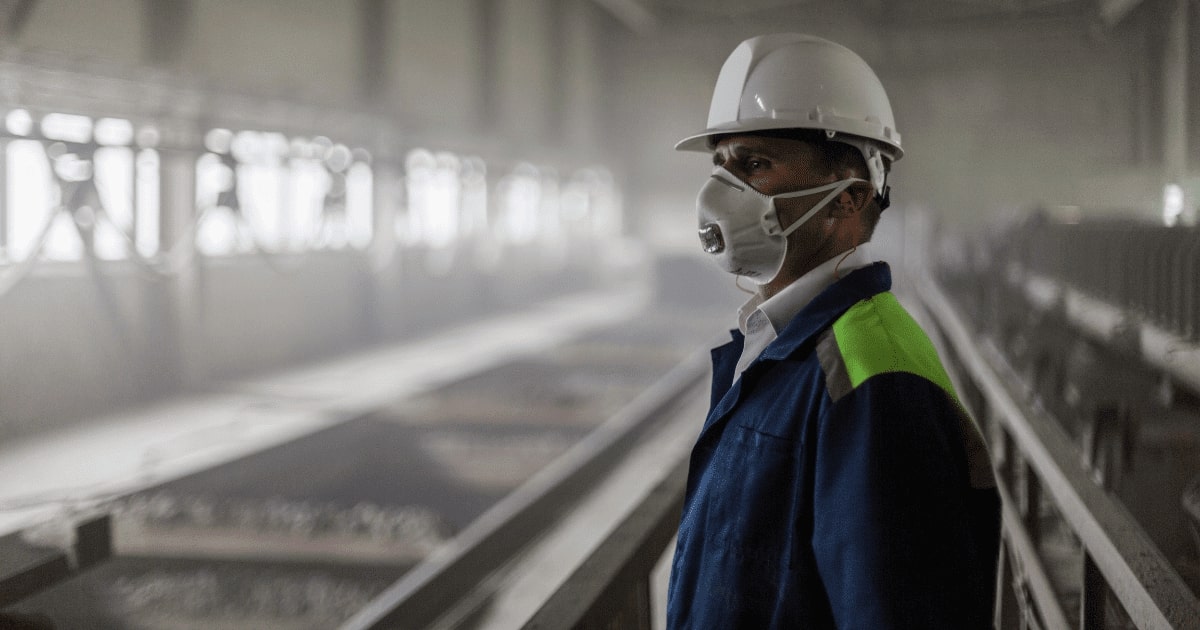Do you need a high-quality work respirator against fine dust? Do you spend a lot of time at home working with wood, painting, or in a very dusty environment? Then you need to protect yourself from dust, as it can cause lung diseases such as silicosis, anthracosis, siderosis, and asbestososis (especially dust from silicon dioxide, coal, iron ore, zinc, aluminum, or even cement).
.jpg)
Why Is It Important to Protect Yourself against Dust when Working?
Inhaling dust can cause permanent damage to the lungs. Some of the most common lung damage includes silicosis, which is caused by inhaling the inorganic material silicon dioxide (SiO2) fibers.
Breathing in ultrafine crystalline silica particles can also cause chronic obstructive pulmonary disease (COPD) or lung cancer. Inhaling mineral dust into the lungs can also cause pneumoconiosis.
Other lung damage caused by inadequate protection when working includes anthracosis (deposition of coal dust in the lungs), siderosis (lungs becoming covered in iron compounds), and asbestosis (interstitial lung fibrosis caused by long-term exposure to asbestos-containing dust).
People who work in very dusty environments also have a higher risk of developing tumors. Tumors are the most common cause of work-related deaths in the European Union, accounting for 53% of the total.
"When should I use a respirator?"
It is recommended to use a respirator when working with anything that can release dangerous particles, dust, or chemicals into the air.

We Recommend Using a Respirator when:
- Working with wood, old furniture,
- Sawing or cutting wood,
- Sanding, painting, varnishing,
- Working with iron,
- Moving in a very dusty environment,
- Working with chemicals,
- Fighting fires,
- Painting, plastering, stuccoing,
- Using nail polish and cosmetics.
How to Choose a Respirator against Fine Dust
In Europe, the level of industrial respirators is compared according to the level of protection FFP or "filtering facepiece". This abbreviation is used for respirators tested according to European industrial standards = industrial respirators. FFP1, FFP2, and FFP3 classes then indicate their level of protection.
The Best Respirator against Dust and Smoke
First, you need to decide what size particles you want to protect yourself from. The size of dust particles ranges from 1-100 µm, particles larger than 30 µm are often called coarse dust (they quickly settle). The smallest particles can have up to 0.001 µm, small particles include smoke (finely dispersed solid matter in the air).

FFP1
FFP1 is the most basic type of respirator that protects against 80% of airborne particles up to a size of 0.6 micrometers. It has the lowest level of filter protection and minimum level of breathing resistance. It is designed to protect against non-toxic and non-fibrogenic dust (crystalline silicon dioxide - quartz, cristobalite, or tridymite, as well as gamma-form alumina). It protects up to a concentration of 5x NPK/PEL, making it suitable for small home DIY tasks.
FFP2
FFP2 face masks filter at least 94% of aerosols (airborne particles) up to a size of 0.6 micrometers. They may also have exhale valves and, compared to FFP1 masks, have a higher level of breathing resistance. They are good for agricultural activities and construction tasks such as plastering and grinding.
They can capture: Harmful mutagenic substances, lung disease and tuberculosis, fibrogenic substances (e.g. crystalline silicon dioxide), aerosols up to a concentration of 10x NPK/PE.
FFP3
If you want the best protection against dust that you can get, then you need an FFP3 respirator. FFP3 face masks filter at least 99% of aerosols (airborne particles) up to a size of 0.6 micrometers. FFP3 respirators provide the highest level of protection and, when properly fitted, can protect against viruses, bacteria, and fine toxic particles such as asbestos. The filter can block up to 99% of particles.
Nanofiber Respirators
Nanofiber respirators exhibit excellent capture efficiency for ultrafine particles (up to 0.02 micrometers). They are therefore considered the highest possible protection against ultrafine dust and toxic substances.
Nanofiber respirators are also available in FFP2 or FFP3 versions, which mainly differ in the quality of the seal. Nanofiber respirators are suitable for respirable dust that commonly penetrates into the periphery of the respiratory tract.
#produkty#https://www.nanospace.store/search/?string=classi
What Is the Difference between FFP, PP, and N Labeling?
You may have also seen the labeling N95, N99, N100, or P1, P2, and P3. These are the non-European equivalents of FFP1, FFP2, and FFP3.
Tip: How to take care of the facade of your house? Find out in our next article: Beautiful even after years. Self-cleaning FN NANO coating will extend the lifespan of your facade by 3 times.
Our Recommendation: Light and Powerful BreaSAFE Respirator
BreaSAFE nanofiber respirators are suitable against very fine dust because they contain a nanofiber membrane that is able to filter it out completely. These respirators can be used for up to 14 days or until they are completely clogged with dust and can be sterilized with suitable disinfection. You can choose between FFP2 and FFP3 respirators.

FAQ - Frequently Asked Questions
- How do I properly fit and wear an FFP face mask?
To properly fit and wear an FFP face mask:
- Start by washing your hands with soap and water or using an alcohol-based hand sanitizer.
- Hold the mask with the metal strip on top and the colored side facing out.
- Place the mask over your nose and mouth, making sure it covers both fully.
- Use the straps or ear loops to secure the mask in place, making sure it fits snugly but comfortably against your face.
- Avoid touching the mask while wearing it, and if you do touch it, wash your hands with soap and water or use an alcohol-based hand sanitizer.
- If the mask becomes damaged or contaminated, replace it with a new one.
- To remove the mask, use the straps or ear loops to carefully remove it from your face without touching the front of the mask.
- After removing the mask, dispose of it properly and wash your hands with soap and water or use an alcohol-based hand sanitizer.
It is important to follow the manufacturer's instructions for fitting and wearing the mask, as well as any guidelines from health authorities. Proper fit and use of the mask is essential for it to be effective in protecting you from airborne particles and other contaminants.
- How long can I use an FFP face mask before it needs to be replaced?
The length of time that an FFP face mask can be used before it needs to be replaced depends on several factors, including the type of mask, the environment in which it is used, and the level of contamination it is exposed to. In general, FFP face masks should be replaced when:
- They become damaged or contaminated.
- The user experiences difficulty breathing through the mask.
- The user can no longer get a good fit from the mask.
- The mask becomes visibly dirty or has an unpleasant odor.
- The manufacturer's recommended lifespan has been reached (this may vary depending on the specific mask and manufacturer).
It is important to follow the manufacturer's instructions and any guidelines from health authorities for replacing your FFP face mask. Proper care and maintenance of the mask can help to extend its lifespan and ensure that it continues to provide effective protection against airborne particles and other contaminants.
- Can FFP face masks protect against viruses and other infectious diseases?
FFP face masks can provide protection against certain airborne particles and other contaminants, but they are not designed to protect against viruses and other infectious diseases. FFP face masks are rated by their filtration efficiency, with the higher-rated masks providing better protection. However, even the highest-rated FFP face masks are not designed to filter out viruses and other infectious agents, and therefore cannot provide complete protection against these types of contaminants.
- What are nanofiber respirators and how do they differ from other FFP face masks?
Nanofiber respirators are a type of FFP face mask that use nanofiber technology in their filters to provide enhanced filtration efficiency for very fine particles. Unlike traditional FFP face masks, which are made of thicker materials such as synthetic fibers, nanofiber respirators use extremely thin fibers to create a filter that is able to capture ultrafine particles with a diameter of 0.1-0.3 micrometers. This makes them more effective at filtering out very fine particles, such as those found in smoke and fumes, than traditional FFP face masks.
Another key difference between nanofiber respirators and other FFP face masks is their breathability. Because of their very thin fibers, nanofiber respirators are able to provide high levels of filtration efficiency without sacrificing breathability, making them more comfortable to wear for long periods of time. They are also typically more durable and can be used for longer periods of time than traditional FFP face masks before needing to be replaced. However, they may be more expensive than other types of FFP face masks
- Are FFP face masks comfortable to wear for long periods of time?
The comfort of an FFP face mask can vary depending on the specific mask and the individual wearing it. Some FFP face masks are designed to be more comfortable than others, with features such as soft materials, adjustable straps, and exhale valves that can help to reduce breathing resistance and make the mask more comfortable to wear for long periods of time. It is important to choose a mask that fits well and is comfortable to wear, as a poorly fitting or uncomfortable mask can cause irritation and make it more difficult to breathe.
In general, FFP face masks may not be as comfortable to wear for long periods of time as other types of masks, such as cloth or surgical masks. This is because they are designed to provide a higher level of filtration efficiency, which can make them more restrictive to breathe through. However, with proper fit and the use of features such as exhale valves, FFP face masks can provide effective protection without causing significant discomfort.
Sources
- Ullah, S., Ullah, A., Lee, J., Jeong, Y., Hashmi, M., Zhu, C., Joo, K.I., Cha, H.J. and Kim, I.S., 2020. Reusability comparison of melt-blown vs nanofiber face mask filters for use in the coronavirus pandemic. ACS Applied nano materials, 3(7), pp.7231-7241.
- Damokhi, A., Yousefinejad, S., Fakherpour, A. and Jahangiri, M., 2022. Improvement of performance and function in respiratory protection equipment using nanomaterials. Journal of Nanoparticle Research, 24(4), p.76.
- Suen, L.K.P., Guo, Y.P., Ho, S.S., Au-Yeung, C.H. and Lam, S.C., 2020. Comparing mask fit and usability of traditional and nanofibre N95 filtering facepiece respirators before and after nursing procedures. Journal of Hospital Infection, 104(3), pp.336-343.
- Skaria, S.D. and Smaldone, G.C., 2014. Respiratory source control using surgical masks with nanofiber media. Annals of occupational hygiene, 58(6), pp.771-781.
- Abbasinia, M., Karimie, S., Haghighat, M. and Mohammadfam, I., 2018. Application of nanomaterials in personal respiratory protection equipment: a literature review. Safety, 4(4), p.47.
- Tcharkhtchi, A., Abbasnezhad, N., Seydani, M.Z., Zirak, N., Farzaneh, S. and Shirinbayan, M., 2021. An overview of filtration efficiency through the masks: Mechanisms of the aerosols penetration. Bioactive materials, 6(1), pp.106-122.
- Akduman, C. and Akcakoca Kumbasar, E.P., 2018, December. Nanofibers in face masks and respirators to provide better protection. In IOP conference series: Materials science and engineering (Vol. 460, p. 012013). IOP Publishing.
- Naragund, V.S. and Panda, P.K., 2022. Electrospun nanofiber-based respiratory face masks—A review. Emergent materials, 5(2), pp.261-278.
- Zhang, Z., Ji, D., He, H. and Ramakrishna, S., 2021. Electrospun ultrafine fibers for advanced face masks. Materials Science and Engineering: R: Reports, 143, p.100594.
- Seidi, F., Deng, C., Zhong, Y., Liu, Y., Huang, Y., Li, C. and Xiao, H., 2021. Functionalized masks: powerful materials against COVID‐19 and future pandemics. Small, 17(42), p.2102453.

Lukáš Konečný has been active in the nano field since 2015. He graduated from the University of Economics and Business and has long been involved in digital marketing, digitisation and automation of advertising for technology companies and online projects. At nanoSPACE, Lukáš has been in charge of strategy and business development since May 2020.
